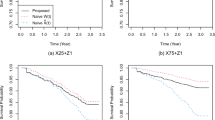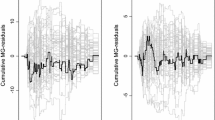Abstract
Survival studies usually collect on each participant, both duration until some terminal event and repeated measures of a time-dependent covariate. Such a covariate is referred to as an internal time-dependent covariate. Usually, some subjects drop out of the study before occurence of the terminal event of interest. One may then wish to evaluate the relationship between time to dropout and the internal covariate. The Cox model is a standard framework for that purpose. Here, we address this problem in situations where the value of the covariate at dropout is unobserved. We suggest a joint model which combines a first-order Markov model for the longitudinaly measured covariate with a time-dependent Cox model for the dropout process. We consider maximum likelihood estimation in this model and show how estimation can be carried out via the EM-algorithm. We state that the suggested joint model may have applications in the context of longitudinal data with nonignorable dropout. Indeed, it can be viewed as generalizing Diggle and Kenward's model (1994) to situations where dropout may occur at any point in time and may be censored. Hence we apply both models and compare their results on a data set concerning longitudinal measurements among patients in a cancer clinical trial.
Similar content being viewed by others
References
D. G. Altman and B. L. De Stavola, “Practical problems in fitting a proportional hazards model to data with updated measurements of the covariates,” Statistics in Medicine vol. 13 pp. 301–341, 1994.
P. K. Andersen, Ø. Borgan, R. D. Gill, and N. Keiding, Statistical Models Based on Counting Processes, Springer-Verlag: New-York, 1993.
D. Collett, Modelling Survival Data in Medical Research, Chapman & Hall: London, 1994.
D. R. Cox, “Regression models and life-tables (with discussion),” Journal of the Royal Statistical Society, Series B vol. 34 pp. 187–220, 1972.
D. R. Cox and D. Oakes, Analysis of Survival Data, Chapman and Hall: London, 1984.
E. A. C. Crouch and D. Spiegelman, “The evaluation of integrals of the form \(\int{_{- \infty}^{ + \infty}}\) f(t) exp (-2) dt: Application to logistic-normal models,” Journal of the American Statistical Association vol. 85 pp. 464–469, 1990.
U. G. Dafni and A. A. Tsiatis, “Evaluating surrogate markers of clinical outcome when measured with error,” Biometrics vol. 54 pp. 1445–1462, 1998.
V. DeGruttola and X. M. Tu, “Modelling progression of CD4-lymphocyte count and its relationship to survival time,” Biometrics vol. 50 pp. 1003–1014, 1994.
A. P. Dempster, N. M. Laird, and D. R. Rubin, “Maximum likelihood from incomplete data via the EM algorithm (with discussion),” Journal of the Royal Statistical Society, Series B vol. 39 pp. 1–38, 1977.
P. J. Diggle and M. G. Kenward,“Informative dropout in longitudinal data analysis (with discussion),” Applied Statistics vol. 43 pp. 49–93, 1994.
J.-F. Dupuy, I. Grama, and M. Mesbah, “Identifiability and consistency in a Cox model with missing time-dependent covariate.” Technical Report SABRES 2001/11, University of South-Brittany, France, 2001.
C. Gourieroux and A. Monfort, Statistique et Modèles Econométriques, Economica, 1996.
J. W. Hogan and N. M. Laird, “Mixture models for the joint distribution of repeated measurements and event times,” Statistics in Medicine vol. 16 pp. 239–257, 1997a.
J. W. Hogan and N. M. Laird, “Model-based approaches to analysing incomplete longitudinal and failure time data,” Statistics in Medicine vol. 16 pp. 259–272, 1997b.
J. D. Kalbfleisch and R. L. Prentice, The Statistical Analysis of Failure Time Data, Wiley: New-York, 1980.
R. J. A. Little, “Modeling the dropout mechanism in repeated-measures studies,” Journal of the American Statistical Association vol. 90 pp. 1112–1121, 1995.
R. J. A. Little and D. B. Rubin, Statistical Analysis with Missing Data, Wiley: New-York, 1987.
T. A. Louis, “Finding the observed information matrix when using the EM algorithm,” Journal of the Royal Statistical Society, Series B vol. 44 pp. 226–233, 1982.
T. Martinussen, “Cox regression with incomplete covariate measurements using the EM-algorithm,” Scandinavian Journal of Statistics vol. 26 pp. 479–491, 1999.
M. Mesbah, J. Lellouch, and C. Huber, “The choice of loglinear models in contingency tables when the variables of interest are not jointly observed,” Biometrics vol. 48 pp. 259–265, 1992.
G. Molenberghs, M. G. Kenward, and E. Lesaffre, “The analysis of longitudinal ordinal data with nonrandom dropout,” Biometrika vol. 84 pp. 33–44, 1997.
S. A. Murphy, “Asymptotic theory for the frailty model,” The Annals of Statistics vol. 23 pp. 182–198, 1995.
G. G. Nielsen, R. D. Gill, P. K. Andersen, and T. I. A. Sørensen, “A counting process approach to maximum likelihood estimation in frailty models,” Scandinavian Journal of Statistics vol. 19 pp. 25–43, 1992.
J. Nocedal and S. J. Wright, Numerical Optimization, Springer: New-York, 1999.
H. J. Ribaudo, S. G. Thompson, and T. G. Allen-Mersh, “A joint analysis of quality of life and survival using a random effect selection model,” Statistics in Medicine vol. 19 pp. 3237–3250, 2000.
D. O. Scharfstein, A. Rotnitzky, and J. M. Robins, “Adjusting for nonignorable dropout using semiparametric nonresponse models (with discussion),” Journal of the American Statistical Association vol. 94 pp. 1096–1146, 1999.
M. D. Schluchter, “Methods for the analysis of informatively censored longitudinal data,” Statistics in Medicine vol. 11 pp. 1861–1870, 1992.
Scilab Group, “Introduction to Scilab.” INRIA Meta2 Project/ENPC Cergrene, User's Guide, 1998.
D. M. Smith, Oswald: Object-Oriented Software for the Analysis of Longitudinal Data in S, WWW page http://www.maths.lancs.ac.uk/Software/Oswald/, 1997.
A. B. Troxel, S. R. Lipsitz, and D. P. Harrington, “Marginal models for the analysis of longitudinal measurements with nonignorable non-monotone missing data,” Biometrika vol. 85 pp. 661–672, 1998.
A. A. Tsiatis and M. Davidian, “A semiparametric estimator for the proportional hazards model with longitudinal covariates measured with error,” Biometrika vol. 88 pp. 447–458, 2001.
A. A. Tsiatis, V. DeGruttola, and M. S. Wulfsohn, “Modeling the relationship of survival to longitudinal data measured with error. Applications to survival and CD4 counts in patients with AIDS,” Journal of the American Statistical Association vol. 90 pp. 27–37, 1995.
G. Verbeke and G. Molenberghs, Linear Mixed Models for Longitudinal Data, Springer-Verlag: New-York, 2000.
M. C. Wu and R. J. Carroll, “Estimation and comparison of changes in the presence of informative right censoring by modelling the censoring process,” Biometrics vol. 44 pp. 175–188, 1988.
M. S. Wulfsohn and A. A. Tsiatis, “A joint model for survival and longitudinal data measured with error,” Biometrics vol. 53 pp. 330–339, 1997.
Author information
Authors and Affiliations
Rights and permissions
About this article
Cite this article
Dupuy, Jf., Mesbah, M. Joint Modeling of Event Time and Nonignorable Missing Longitudinal Data. Lifetime Data Anal 8, 99–115 (2002). https://doi.org/10.1023/A:1014871806118
Issue Date:
DOI: https://doi.org/10.1023/A:1014871806118




